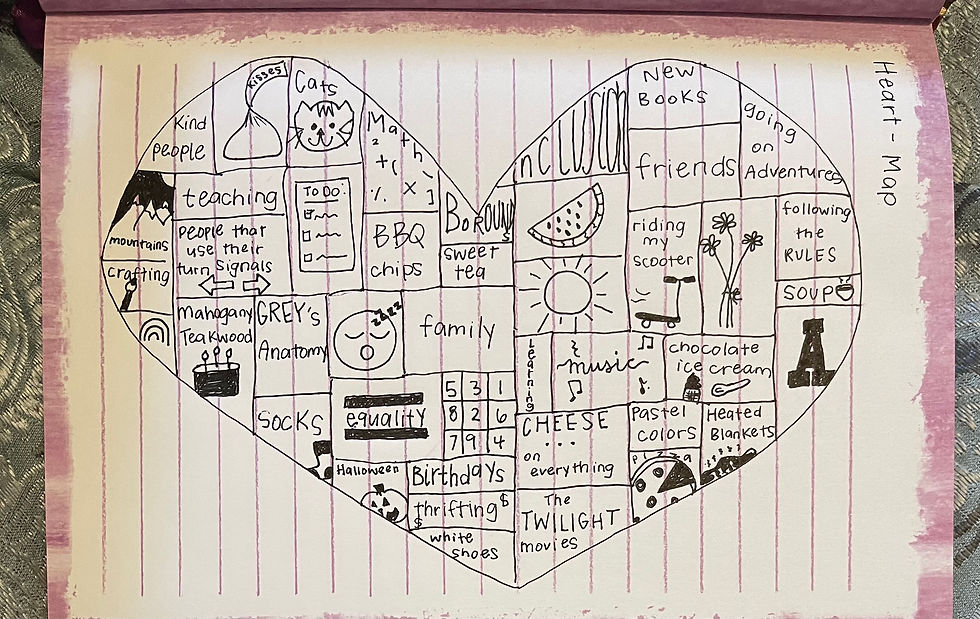What to Write?
- harrisonse
- Feb 10, 2021
- 7 min read
Sometimes it can be challenging to decide what to write about. There are so many different topics, how could you possibly choose just one? Even if you could pick one topic to write about then you still have the challenge of choosing what to say and how to say it. This task can be difficult for anyone but especially beginning writers who are trying to discover who they are as a writer. Beginning writers are still discovering what writing is and what it means to be a writer, but this is not something they can do on their own. Although all students may not struggle with this, it is important to be prepared to provide your beginning writers with a substantial amount of support to aid them in getting started. Since choosing a single writing topic can be difficult it is important for educators to learn a plethora of writing ideas and strategies to share with their students. Recently I have been researching new ideas through exploring Textbook Amy Krouse Rosenthal and Mentor Texts: Teaching Writing Through Children's Literature, K-6 and that is what I will be discussing this week.
In these two texts I have found an extensive amount of inspiration to write myself. Until this year if someone told me to sit and solely write for five minutes I would have been lost, sitting there probably just describing the events that occurred that day. After diving into these two intriguing books I can now think of several different writing strategies I want to try and there are a few that I have already tried in my writer's notebook. This week the strategies I learned about involved students digging deep to think of topics that mean something to them. A few strategies highlighted were creating a heart map, a hand map, and an inverted triangle. I have actually tried each of these strategies and I will share those experiences with you throughout this post!
The first strategy I will discuss today is a heart map. A heart map is essentially a list you create of all the different things that are in your heart, or that you love, in life. You can invite students to try out this strategy by either creating a handwritten list, filling out a blank heart diagram, or drawing pictures to share all the things they love. This is a great strategy since it can be implemented with writers of all ages because of the different modifications you can apply. For older students a written list may work best whereas for younger students who are still learning how to write a picture list may be better, you could also use speech-to-text for any students with physical disabilities. After your students create their own heart maps, they could choose one of the items on their list to write about in their writer's notebook, or anywhere for that matter. A writer's notebook can be a great place for students to collect writing ideas, share their ideas, or practice their writing skills. I can attest that my writer's notebook has truly encouraged me to experiment with my writing more and I bet it would have that same affect on students. Here I will include a picture of my own heart map!


You could begin a lesson on heart maps on its own or you could introduce it using a book. This week I read a book titled Happy Like Soccer, written by Maribeth Boelts and illustrated by Lauren Castillo, which could be used as an introduction to this lesson. In this book a young girl named Sierra's love for soccer is shared. Sierra says to us that soccer makes her happy because it is something she enjoys doing but it can also make her sad because her family members cannot come support her. Sierra shares the ritual her family has adopted involving her soccer games; her auntie helps her get ready and hugs her goodbye, she is picked up by the carpool, she plays her heart out while also realizing there is no one in the stands cheering her name, and she ends the night by having a dinner of chicken and noodles with her auntie as they discuss the happenings of the game. In the end, Sierra reached out to her coach to see if they could schedule their final game on a night when her auntie was available. To her surprise, Sierra's coach said yes and she was able to play her last game of the season with her auntie cheering her on from the sidelines! This was such a beautiful ending to the story and it shows the reader that there are good days and bad days but luckily you have a say sometimes.
I thought you could connect this to the heart map lesson by first showing what would be in Sierra's heart map, or even your own. For example, Sierra's heart map may include soccer, her auntie, coach Marco, the girls on her soccer team, playing soccer in the lot by her house, or eating chicken and noodle dinners with her auntie, there are many different possibilities to pull from the book. Once this has been done you could then challenge each of your students to begin their own heart map. They can be quite extensive so it may not be a single day activity, but rather one your students could revisit when necessary in the future.
Another activity I think would work well with this book are the hand maps I mentioned earlier. To create a hand map you will need a traced out picture of your hand and potentially a list of feelings to share with students for ideas. Each finger will have a designated feeling, and branching off of that finger you will write what experiences you have had that made you feel that way. If you choose to use this activity with a book, you may ask students to write down feelings a character in a story felt, then write what experiences from the book made them feel that way. This week I chose to try this activity out, which was shared with me in the third chapter of Mentor Texts, with a first grade student I work with each week. Since I knew that this student loved soccer I thought this would be an easier book for her to connect to on an emotional level, perfect for this activity. After reading this book together we first went over my example of a hand map, I shared the feelings I chose and how they related to both me and the character (although I only recorded my experiences) which I will include an image of below.

Next the student and I worked together to curate her own ideas to add to her hand map. I completed the writing but the words came directly from the student. I was impressed by not only the feelings this student chose to list, but also how insightful she was when sharing both her experiences and Sierra's that related to each feeling. Here I will include a picture of the student's hand map.

The last strategy I will discuss is the inverted triangle. This strategy is a way for students to narrow down their chosen topic for writing. First you will want your students to create a list of different writing ideas, or writing territories, so they have plenty of topics to choose from when it is time to write. Although just having this list could be helpful, the inverted triangle takes students' writing a step further by challenging them to narrow down their topic to one specific event or object, rather than trying to discuss every element from one topic in a single piece of writing. In chapter three of Mentor Texts: Teaching Writing Through Children's Literature, K-6 the author says that it is possible for her to write an entire encyclopedia series about her grandfather but that cannot fit into one concise story, so instead she chose to write about one specific memory she had with her grandpa. So her inverted triangle started with "Grandpa" and ended with one specific story which she decided to share. Doing this allows the writer to hug their idea tight and provide a substantial number of details thus making their story stronger and more interesting to read. I was inspired by this and chose to create my own inverted triangle, which I could write about in the future now that I have already completed the planning process through this experience.


This week I also had the pleasure of reading Mango, Abuela, and Me written by Meg Medina and illustrated by Angela Dominguez. Although I did not complete any writing activities centered around this book this week, it is still such a sweet story that I just had to share! I have, however, incorporated this book into a six week curricular unit centered on promoting a positive self identity among LatinX identifying students, so it is one of my favorites. In this story Mia is a little worried because her Abuela, who only speaks Spanish, is coming to stay with her and her family. Even though her family has a Spanish background, she is not fluent in the language and wonders how she and her grandmother will converse. I think this is an experience many students may have, especially growing up in a country where English is the primary language and Spanish is avoided, so I appreciated this narrative being discussed. It is crucial for you to share children's literature with your students that step away from the traditional one story narrative so that each of your students see themselves represented in the books you are reading rather than only a select few. Once Mia's Abuela arrives they begin teaching each other English and Spanish. Even though the two could not talk very much, this shared experience allowed them to bond through their teachings and discussions. Towards the end of the story both Mia and Abuela's language skills had improved and they could now use their newly learned language with ease compared to at the start of their journey.

More about the book creators:
Happy Like Soccer:
Author: Maribeth Boelts

Illustrator: Lauren Castillo

Mango, Abuela, and Me:
Author: Meg Medina

Illustrator: Angela Dominguez



Comments